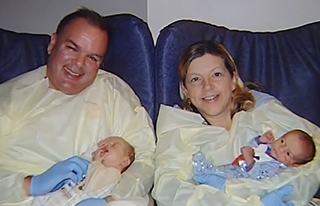
| Oct. 2015 | |||||||||||
| Top stories | |||||||||||
| In the news | |||||||||||
| Photos | |||||||||||
| Contact us | |||||||||||
| Archive | |||||||||||
|
Perfect food passes test for infants |
Human milk is the perfect food for most infants. But, because “Baby M” was born 10 weeks early, her mother wasn’t able to produce enough milk to sustain her. Formula was available, but couldn’t replicate the many benefits of mother’s milk.
Updated in November 2009
Baby M’s parents and doctors agreed that donor breast milk would be the best alternative, and turned to the Mother’s Milk Bank of Iowa to meet the need.
The Mother’s Milk Bank (MMB) helps feed preemies like Baby M and other newborns with breast milk donated by women who are breastfeeding their own babies. It is one of 19 Human Milk Banking Association of North America (HMBANA) donor banks that provide human donor milk throughout the US and in three Canadian provinces.
Jean Drulis and Dr. Ekhard Ziegler created the program in 2002 as part of the University of Iowa Children’s Hospital. The following year, MMB began distributing its first bottles of pasteurized milk after recruiting and screening donors, establishing procedures, and creating a process that ensured the milk was safe for babies.

Susan and Tom Roeder
One of HMBANA’s goals is to make sure the donor milk adheres to mandatory guidelines that protect babies from possible disease transmission from donated milk. To do so, they use a four-step process: donor screening for medical and lifestyle risk factors, serum testing, pasteurization and post-pasteurization testing. In Iowa this testing is performed by the Hygienic Laboratory.
“Donor milk through HMBANA member banks has never been linked to transmission of disease,” Drulis said.
The laboratory’s Environmental Microbiology section and its manager Nancy Hall have worked with the donor bank since its beginning, testing more than a thousand breast milk samples a year to check for pasteurization effectiveness.
Hall has also been an integral part of HMBANA’S efforts to establish a uniform standard operating procedure for testing milk post-pasteurization. She joined Drulis and Dr. Christine Ziebold, University of Iowa pediatric infectious disease specialist, on the 10-person Microbiology Advisory Committee. Prior to that, each bank had its own best practice standard.
The committee produced the “Quantitative Analysis of Bacteria in Mothers’ Milk” as an appendix to the HMBANA Guidelines for the Establishment and Operation of a Donor Human Milk Bank. It was published in 2013 and authored by Hall.
“The MMB is in good hands with her directing the testing of the milk we process. [Hall] was and is instrumental in the safety assessments of the milk,” Drulis said.
Following the HMBANA guidelines, donor banks can keep the milk safe to drink for up to one year – if frozen – after pooling milk from multiple donors, bottling, pasteurizing and testing. Recipient hospitals maintain an inventory of bottles, ordering weekly as their needs dictate. The MMB rarely has an inventory, but usually dispenses the milk as soon as it passes its culture tests performed at the Hygienic Laboratory.
MMB is mainly supported by and serves Iowans, but has sent milk to wherever there is a need. Last year, milk was sent to 33 hospitals —10 in Iowa and 23 in 14 other states.
“Because each bank adheres to the same guidelines, when a bank is temporarily unable to supply to a recipient, it contacts other banks for assistance,” Drulis said.
In 2003, MMB distributed 3,001 ounces of milk. Since then it has greatly increased production each year with 148,846 ounces being distributed in 2014 in Iowa and 14 other states. Of the donor milk supplied in 2014, 88 percent was dispensed to hospitals with the remaining 12 percent to infants at home.
“The Hygienic Laboratory is very proud to be a part of this important program for Iowa hospitals, mothers and infants who need this service,” Hall said.
And Baby M would probably agree.